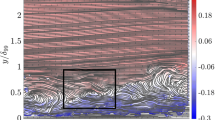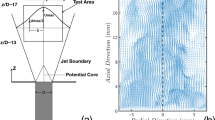Abstract
Measurements using stereo particle image velocimetry are presented for a developing turbulent boundary layer in a wind tunnel with a Mach 2.75 free stream. As the boundary layer exits from the tunnel nozzle and moves through the wave-free test section, small initial departures from equilibrium turbulence relax, and the boundary layer develops toward the equilibrium zero-pressure-gradient form. This relaxation process is quantified by comparison of first and second order mean, fluctuation, and gradient statistics to classical inner and outer layer scalings. Simultaneous measurement of all three instantaneous velocity components enables direct assessment of the complete turbulence anisotropy tensor. Profiles of the turbulence Mach number show that, despite the M = 2.75 free stream, the incompressibility relation among spatial gradients in the velocity fluctuations applies. This result is used in constructing various estimates of the measured-dissipation rate, comparisons among which show only remarkably small differences over most of the boundary layer. The resulting measured-dissipation profiles, together with measured profiles of the turbulence kinetic energy and mean-flow gradients, enable an assessment of how the turbulence anisotropy relaxes toward its equilibrium zero-pressure-gradient state. The results suggest that the relaxation of the initially disturbed turbulence anisotropy profile toward its equilibrium zero-pressure-gradient form begins near the upper edge of the boundary layer and propagates downward through the defect layer.





















Similar content being viewed by others
References
Alving A, Smits A, Watmuff J (1990) Turbulent boundary-layer relaxation from convex curvature. J Fluid Mech 211:529–556
Aubertine C, Eaton J (2005) Turbulence development in a non-equilibrium turbulent boundary layer with mild adverse pressure gradient. J Fluid Mech 532:345–364
Bardina J, Huang P, Coakley T (1980) Turbulence modeling validation, testing, and development. NASA Technical Memorandum 110446
Castillo L, George W (2001) Similarity analysis for turbulent boundary layer with pressure gradient: outer flow. AIAA J 39(1):41–47
Clemens N, Mungal M (1991) A planar mie scattering technique for visualizing supersonic mixing flows. Exp Fluids 11:175–185
Coles D (1954) Measurements of turbulent friction on a smooth flat plate in supersonic flows. J Aeronaut Sci 21:433–448
Coles D, Hirst E (1968) Computation of turbulent boundary layers—1968 AFOSR-IFP Stanford conference. In: Proceedings of the 1968 conference 2, Stanford University, Stanford, CA
Cutler A, Johnston J (1989) The relaxation of a turbulent boundary-layer in an adverse pressure-gradient. J Fluid Mech 200:367–387
Dussauge J, Fernholz H, Smith R, Finley P, Smits A, Spina E (1996) Turbulent boundary layers in subsonic and supersonic flows. Technical report, Advisory Group for Aerospace Research & Development (AGARD)
Elsberry K, Loeffler J, Zhou D, Wygnanski I (2000) An experimental study of a boundary layer that is maintained on the verge of separation. J Fluid Mech 423:227–261
Erm L, Smits A, Joubert P (1985) Low Reynolds number turbulent boundary layers on a smooth flat surface in a zero-pressure-gradient. In: Proceedings of the Fifth Symposium on Turbulent Shear Flows, Cornell University
Fernholz H, Finley P (1980) A critical commentary on mean flow data for two-dimensional compressible turbulent boundary layers. AGARDograph 253
Ganapathisubramani B, Clemens N, Dolling D (2006) Large-scale motions in supsersonic turbulent boundary layer. J Fluid Mech 556:271–282
Guarini S, Moser R, Shariff K, Wray A (2000) Direct numerical simulation of a supersonic turbulent boundary layer at Mach 2.5. J Fluid Mech 414:1–33
Hamlington P, Dahm W (2008) Reynolds stress closure for nonequilibrium effects in turbulent flows. Phys Fluids 20: 115101
Hamlington P, Dahm W (2009) Frequency response of periodically-sheared homogeneous turbulence. Phys Fluids 21: 055107
Humble R, Scarano F, van Oudheusden B (2007) Particle image velocimetry measurements of a shock wave/turbulent boundary layer interaction. Exp Fluids 43:173–183
Kim J, Moin P, Moser R (1987) Turbulence statistics in fully developed channel flow at low Reynolds number. J Fluid Mech 177:133–166
Lapsa A (2009) Experimental study of passive ramps for control of shock-boundary layer interactions. PhD thesis, The University of Michigan
Lawson N, Wu J (1997) Three-dimensional particle image velocimetry: experimental error analysis of a digital angular stereoscopic system. Measure Sci Technol 8:1455–1464
Maeder T, Adams N, Kleiser L (2001) Direct simulation of turbulent supersonic boundary layers by an extended temporal approach. J Fluid Mech 429:187–216
Maise G, McDonald H (1968) Mixing length and kinematic eddy viscosity in a compressible boundary layer. AIAA J 6(1):73–80
Martin M (2007) Direct numerical simulation of hypersonic turbulent boundary layers. Part 1. Initialization and comparison with experiments. J Fluid Mech 570:347–364
Melling A (1997) Tracer particles and seeding for particle image velocimetry. Measur Sci Technol 8:1406–1416
Mullin J, Dahm W (2005) Dual-plane stereo particle image velocimetry (DSPIV) for measuring velocity gradient fields at intermediate and small scales of turbulent flows. Exp Fluids 38:185–196
Mullin J, Dahm W (2006a) Dual-plane stereo particle image velocimetry measurements of velocity gradient tensor fields in turbulent shear flow. I. Accuracy assessments. Phys Fluids 18:035101
Mullin J, Dahm W (2006b) Dual-plane stereo particle image velocimetry measurements of velocity gradient tensor fields in turbulent shear flow. II. Experimental results. Phys Fluids 18:035102
Pirozzoli S, Grasso F, Gatski T (2004) Direct numerical simulation and analysis of a spatially evolving supersonic turbulent boundary layer at M=2.25. Phys Fluids 16:530–545
Pirozzoli S, Bernardini M, Grasso F (2008) Characterization of coherent vortical structures in a supersonic turbulent boundary layer. J Fluid Mech 613:205–231
Pope S (2000) Turbulent flows. Cambridge University Press, Cambridge
Prasad A, Jensen K (1995) Scheimpflug stereocamera for particle image velocimetry in liquid flows. Appl Opt 34:7092–7099
Raffel M, Willert C, Kompenhans J (1998) Particle image velocimetry: a practical guide. Springer, New York
Ringuette M, Wu M, Martin M (2008) Coherent structures in direct numerical simulation of turbulent boudnary layers at Mach 3. J Fluid Mech 594:56–69
Ringuette M, Bookey P, Wyckham C, Smits A (2009) Experimental study of a Mach 3 compression ramp interaction at Re θ = 2400. AIAA J 47(2):373–385
Samimy M, Lele S (1991) Motion of particles with inertia in a compressible free shear layer. Phys Fluids 3:1915–1923
Scarano F (2008) Particle image velocimetry: new developments and recent applications. Springer, Berlin
Smith D, Smits A (1997) The effects of successive distortions on a turbulent boundary layer in a supersonic flow. J Fluid Mech 351:253–288
Smits A (1997) Compressible turbulent boundary layers. In: Turbulence in compressible flows, AGARD report AGARD-R-819
Spalart P (1988) Direct simulation of a turbulent boundary layer up to Re θ = 1410. J Fluid Mech (187):61–98
Spina E, Smits A, Robinson S (1994) The physics of supersonic turbulent boundary layers. Annu Rev Fluid Mech 26:287–319
Tani I (1987) Equilibrium, or nonequilibrium, of turbulent boundary layer flows. Proc Japan Acad 63(B):96–100
White F (1991) Viscous fluid flow, 2nd edn. McGraw-Hill Inc., New York
Wu M, Martin M (2008) Analysis of shock motion in shockwave and turbulent boundary layer interaction using direct numerical simulation data. J Fluid Mech 594:71–83
Zucrow M, Hoffman J (1976) Gas Dynamics. Wiley, New York
Author information
Authors and Affiliations
Corresponding author
Rights and permissions
About this article
Cite this article
Lapsa, A.P., Dahm, W.J.A. Stereo particle image velocimetry of nonequilibrium turbulence relaxation in a supersonic boundary layer. Exp Fluids 50, 89–108 (2011). https://doi.org/10.1007/s00348-010-0897-x
Received:
Revised:
Accepted:
Published:
Issue Date:
DOI: https://doi.org/10.1007/s00348-010-0897-x




